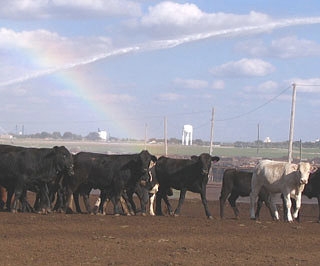Air Quality Issues and Animal Agriculture: A Primer
Contents
Introduction
Emissions of gaseous substances from agricultural operations has assumed a major focus in international views of air pollution and greenhouse gas production. The magnitude of these emissions is noteworthy, chiefly due to the dramatic expansion of the human population in the last century, placing enormous pressure on the magnitude of agricultural production. Methane is one of the key gases produced in such agricultural activity, since it is emitted in massive quantities from livestock operations as well as rice farming. In particular, as a radiative forcing factor, methane is known to be about thirty times more potent than carbon monoxide in influencing atmospheric temperature change.
Summary of the U.S. Congressional Research Service report
From an environmental quality standpoint, much of the public and policy interest in animal agriculture has focused on impacts on water resources, because animal waste, if not properly managed, can harm water quality through surface runoff, direct discharges, spills, and leaching into soil and groundwater. A more recent issue is the contribution of air emissions from animal feeding operations (AFOs), enterprises where animals are raised in confinement. This report provides background on the latter issue.
AFOs can affect air quality through emissions of gases such as ammonia, methane, hydrogen sulfide, particulate matter, volatile organic compounds, hazardous air pollutants and odor. These pollutants and compounds have a number of environmental and human health effects.
Agricultural operations have been treated differently from other businesses under numerous federal and state laws. Some environmental laws specifically exempt agriculture from regulatory provisions, and some are designed so that farms are not subject to most, if not all, of the regulatory impact. The primary regulatory focus on environmental impacts has occurred under the Clean Water Act. In addition, AFOs that emit large quantities of air pollutants may be subject to Clean Air Act regulation. Some livestock operations also may be regulated under the release reporting requirements of the Comprehensive Environmental Response, Compensation, and Liability Act (CERCLA) and the Emergency Planning and Community Right-to-Know Act (EPCRA). Questions about the applicability of these laws to livestock and poultry operations have been controversial and have drawn congressional attention. Agriculture’s role as both a source of and a “sink” for greenhouse gases also has been of interest recently in connection with addressing the global challenge of climate change.
Enforcement of environmental laws requires accurate measurement of emissions to determine whether regulated pollutants are emitted in quantities that exceed specified thresholds. Two reports by the National Research Council evaluated the current state of the science and approaches for estimating AFO air emissions to guide future management and regulatory efforts. In an effort to collect scientifically credible data on air emissions, in January 2005 the Environmental Protection Agency (EPA) announced a plan negotiated with segments of the animal agriculture industry. Called the Air Compliance Agreement, it is intended to produce air quality monitoring data on AFO emissions, while at the same time protecting participants through a “safe harbor” from liability under certain provisions of federal environmental laws. Issues related to this agreement, which has been controversial among environmental advocates, state and local air quality officials, and some industry groups, are discussed separately in CRS Report RL32947, Air Quality Issues and Animal Agriculture: EPA’s Air Compliance Agreement.
Results of the 2010 congressional elections have altered political dynamics in Congress on many issues, and different approaches are anticipated in the 112th Congress. Many stakeholders anticipate that through oversight or legislative proposals, the 112th Congress will be interested in examining how EPA’s activities, including many discussed in this report, may affect agriculture.
Editor's note
Portions of this entry were taken from the Congressional Research Service Report RL32948 by Claudia Copeland
